
Nymphaeaceae is a family of flowering plants, commonly called water lilies. They live as rhizomatous aquatic herbs in temperate and tropical climates around the world. The family contains five genera with about 70 known species. Water lilies are rooted in soil in bodies of water, with leaves and flowers floating on or emergent from the surface. Leaves are round, with a radial notch in Nymphaea and Nuphar, but fully circular in Victoria and Euryale.
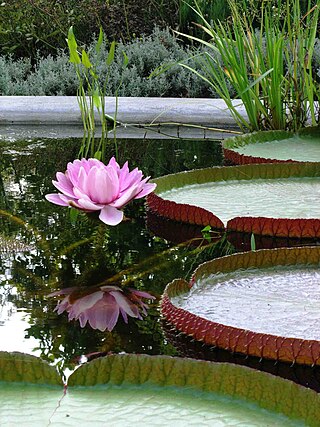
Victoria or giant waterlily is a genus of water-lilies, in the plant family Nymphaeaceae, with very large green leaves that lie flat on the water's surface. Victoria boliviana has a leaf that is up to 3 metres (9.8 ft) in width, on a stalk up to 8 metres (26 ft) in length. The genus name was given in honour of Queen Victoria of the United Kingdom. It pushes other water plants aside as it spreads out until only those of its kind remains. When this happens it has nearly completely cut out the sunlight from getting to any plants below the water limited only by circle packing.
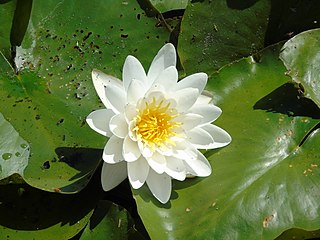
Nymphaea is a genus of hardy and tender aquatic plants in the family Nymphaeaceae. The genus has a cosmopolitan distribution. Many species are cultivated as ornamental plants, and many cultivars have been bred. Some taxa occur as introduced species where they are not native, and some are weeds. Plants of the genus are known commonly as water lilies, or waterlilies in the United Kingdom. The genus name is from the Greek νυμφαία, nymphaia and the Latin nymphaea, which mean "water lily" and were inspired by the nymphs of Greek and Latin mythology.

Nelumbo is a genus of aquatic plants with large, showy flowers. Members are commonly called lotus, though the name is also applied to various other plants and plant groups, including the unrelated genus Lotus. Members outwardly resemble those in the family Nymphaeaceae, but Nelumbo is actually very distant from that family.
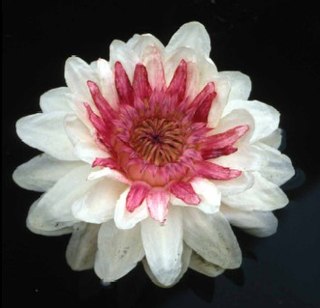
Victoria cruziana is a tropical species of flowering plant, of the Nymphaeaceae family of water lilies native to South America, primarily Brazil, Bolivia, Argentina and Paraguay.
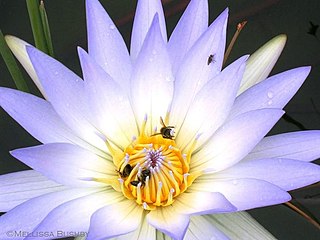
Nymphaea nouchali var. caerulea, is a water lily in the genus Nymphaea, a botanical variety of Nymphaea nouchali.

Euryale ferox, commonly known as prickly waterlily, makhana or Gorgon plant, is a species of water lily found in southern and eastern Asia, and the only extant member of the genus Euryale. The edible seeds, called fox nuts or makhana when dried, are eaten in Asia.

Nuphar lutea, the yellow water-lily, brandy-bottle, or spadderdock, is an aquatic plant of the family Nymphaeaceae, native to northern temperate and some subtropical regions of Europe, northwest Africa, and western Asia. This species was used as a food source and in medicinal practices from prehistoric times with potential research and medical applications going forward.

Nymphaea leibergii, also known as the dwarf waterlily and Leiberg's waterlily, is a perennial emergent aquatic plant belonging to the genus Nymphaea. It can be found across northern North America in ponds and slow moving streams. Populations of this plant are infrequent throughout its range, and it is protected as a state threatened plant in Maine, Michigan, and Minnesota.

Nymphaea thermarum is a species of water lily that is endemic to Rwanda. Once thought to be extinct in the wild, all wild plants were believed to be lost due to destruction of its native habitat, but it was thought to be saved from extinction when it was grown from seed at the Royal Botanic Gardens, Kew in 2009. A previously-unknown wild population was discovered in 2023.

Cyclocephala castanea is a species of small beetle in the family Scarabaeidae which is native to the Amazon basin in South America. This beetle and certain others in the same genus have a commensal relationship with the large water lily Victoria amazonica. Visiting the flower for food, the beetles are trapped inside and emerge laden with pollen the following evening.
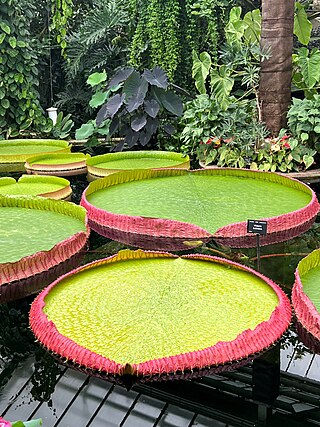
Victoria boliviana, or the Bolivian waterlily is a new species of water lily within the genus Victoria in the family Nymphaeaceae. It is the newest described species of the genus and its largest member in size and was officially identified in 2022. In January 2023, the species was awarded three Guinness World Record titles for world's largest waterlily species, world's largest waterlily leaf and world's largest undivided leaf, with the latter two specifically recognizing a specimen grown in 2012 at La Rinconada Gardens in Santa Cruz, Bolivia.
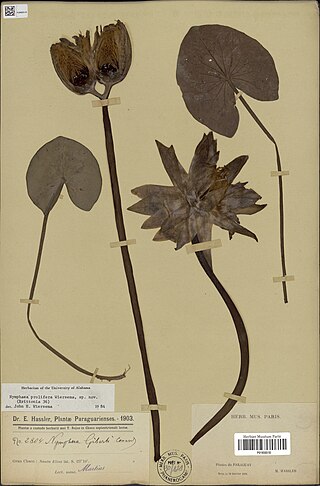
Nymphaea prolifera is a species of waterlily naturally found from Mexico to Brazil and northeastern Argentina. Additionally, it has been reported to occur in Uruguay.

Nymphaea gardneriana is a species of waterlily native to Cuba and tropical South America.
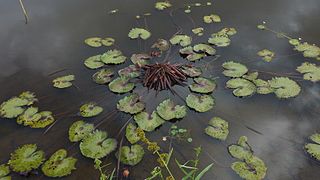
Nymphaea rudgeana is a species of waterlily native to the region spanning from Mexico to tropical South America.
Nymphaea tenuinervia is a species of waterlily native to Colombia, Guyana and Brazil.

Nymphaea lasiophylla is a species of waterlily native to East Brazil. It has also been introduced to the Venezuelan Antilles.

Nymphaea atrans is a species of waterlily is endemic to Queensland, Australia.

Nymphaea gracilis is a species of waterlily endemic to Mexico. It is the only species of its genus, which is endemic to Mexico.

Nymphaea loriana is a species of waterlily endemic to Manitoba, and Saskatchewan, Canada.
































